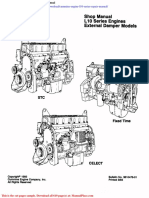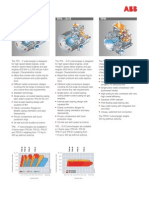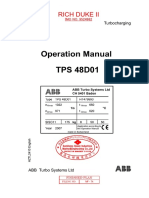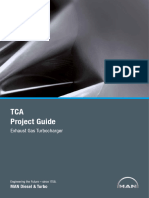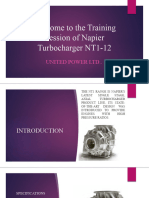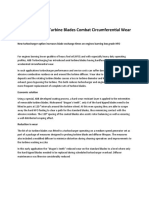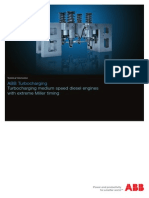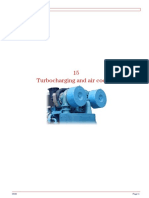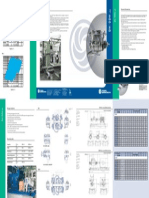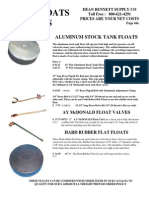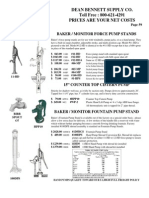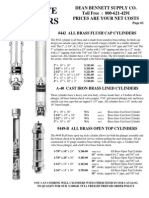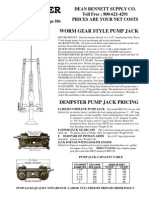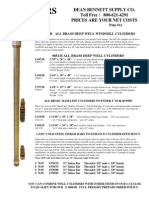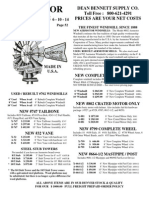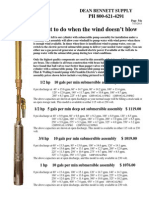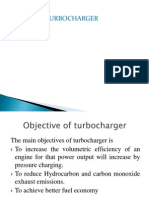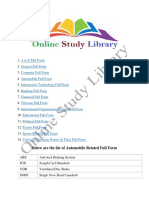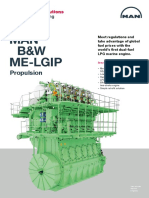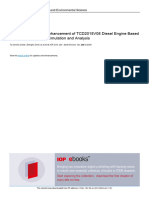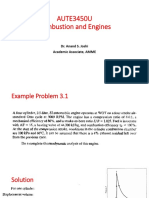0 ratings0% found this document useful (0 votes)
129 viewsDevelopment High-Efficiency Turbocharger Met-Ma
Development High-Efficiency Turbocharger Met-Ma
Uploaded by
cristobal_tl2277Mitsubishi Heavy Industries developed a new high-efficiency turbocharger called the MET-MA series to improve the efficiency of large-bore diesel engines and turbo compound systems. The MET-MA features a redesigned turbine blade with a curved three-dimensional shape to optimize gas flow. Computational analysis was used to optimize the gas outlet casing design. Performance testing showed the turbine efficiency of the MET-MA was approximately 2% higher than previous models. Overall turbocharger efficiency for the MET-83MA was over 70% at high pressure ratios, around 2% better than earlier designs. The improved MET-MA turbocharger is expected to increase the efficiency of diesel engines and exhaust heat recovery systems.
Copyright:
© All Rights Reserved
Available Formats
Download as PDF, TXT or read online from Scribd
Development High-Efficiency Turbocharger Met-Ma
Development High-Efficiency Turbocharger Met-Ma
Uploaded by
cristobal_tl22770 ratings0% found this document useful (0 votes)
129 views3 pagesMitsubishi Heavy Industries developed a new high-efficiency turbocharger called the MET-MA series to improve the efficiency of large-bore diesel engines and turbo compound systems. The MET-MA features a redesigned turbine blade with a curved three-dimensional shape to optimize gas flow. Computational analysis was used to optimize the gas outlet casing design. Performance testing showed the turbine efficiency of the MET-MA was approximately 2% higher than previous models. Overall turbocharger efficiency for the MET-83MA was over 70% at high pressure ratios, around 2% better than earlier designs. The improved MET-MA turbocharger is expected to increase the efficiency of diesel engines and exhaust heat recovery systems.
Original Title
Development High-efficiency Turbocharger Met-ma
Copyright
© © All Rights Reserved
Available Formats
PDF, TXT or read online from Scribd
Share this document
Did you find this document useful?
Is this content inappropriate?
Mitsubishi Heavy Industries developed a new high-efficiency turbocharger called the MET-MA series to improve the efficiency of large-bore diesel engines and turbo compound systems. The MET-MA features a redesigned turbine blade with a curved three-dimensional shape to optimize gas flow. Computational analysis was used to optimize the gas outlet casing design. Performance testing showed the turbine efficiency of the MET-MA was approximately 2% higher than previous models. Overall turbocharger efficiency for the MET-83MA was over 70% at high pressure ratios, around 2% better than earlier designs. The improved MET-MA turbocharger is expected to increase the efficiency of diesel engines and exhaust heat recovery systems.
Copyright:
© All Rights Reserved
Available Formats
Download as PDF, TXT or read online from Scribd
Download as pdf or txt
0 ratings0% found this document useful (0 votes)
129 views3 pagesDevelopment High-Efficiency Turbocharger Met-Ma
Development High-Efficiency Turbocharger Met-Ma
Uploaded by
cristobal_tl2277Mitsubishi Heavy Industries developed a new high-efficiency turbocharger called the MET-MA series to improve the efficiency of large-bore diesel engines and turbo compound systems. The MET-MA features a redesigned turbine blade with a curved three-dimensional shape to optimize gas flow. Computational analysis was used to optimize the gas outlet casing design. Performance testing showed the turbine efficiency of the MET-MA was approximately 2% higher than previous models. Overall turbocharger efficiency for the MET-83MA was over 70% at high pressure ratios, around 2% better than earlier designs. The improved MET-MA turbocharger is expected to increase the efficiency of diesel engines and exhaust heat recovery systems.
Copyright:
© All Rights Reserved
Available Formats
Download as PDF, TXT or read online from Scribd
Download as pdf or txt
You are on page 1of 3
Mitsubishi Heavy I ndustries, Ltd.
Technical Review Vol. 43 No. 1 (J an. 2006)
1
1. I ntroduction 1. I ntroduction 1. I ntroduction 1. I ntroduction 1. I ntroduction
A turbocharger is a machine that recovers exhaust gas
energy using a turbine and drives an axial compressor to
feed air required for combustion. To respond to high out-
put of recent large-bore diesel engines, the turbocharger
must have a high pressure ratio of compressor and en-
hanced turbocharger efficiency.
Further, the turbo compound system that partially re-
covers exhaust gas energy as driving force is recently
attracting attention, with the need for high-efficiency tur-
bocharger increasing.
This paper presents a report on the development of the
latest high-efficiency MET-MA turbocharger.
2. MET turbocharger overview 2. MET turbocharger overview 2. MET turbocharger overview 2. MET turbocharger overview 2. MET turbocharger overview
2.1 History of MET turbocharger 2.1 History of MET turbocharger 2.1 History of MET turbocharger 2.1 History of MET turbocharger 2.1 History of MET turbocharger
The MET turbocharger was first developed in 1965
for the Mitsubishi UE 2-cycle low speed diesel engine.
To respond to the need for higher engine output, the tur-
Development of
High-efficiency Turbocharger
MET-MA Series for Large-Bore
Diesel Engine
1960 1970 1980 1990 2000
4
3
2
MET .. O
MET-S,-SA
MET-SB,-SBII
MET-SC
MET-SD
MET-SE
SEII
MET-MA
Fig. 1 History of Mitsubishi MET turbocharger
C
o
m
p
r
e
s
s
o
r
p
r
e
s
s
u
r
e
r
a
t
i
o
Original MET
Water-cooled turbocharger
Year
MET-S, SA
MET-S, SA
MET-SB, SC, SD
MET-SB MET-SC MET-SD, SE, SEII
MET-SE, SEII
Fig. 2 Changes in Mitsubishi MET turbocharger compressor impellers and turbine blades
2 pieces wheel,
non-backward impeller
(1973)
2 pieces, backward impeller
(1982)
one body impeller
(1984)
one body impeller
with split blade
(1990)
Impeller with damping wire
(1973)
Free standing blade
(1982)
Free standing blade,
wide chord
(1995)
bocharger has undergone the model changes as shown
in Fig. 1 Fig. 1 Fig. 1 Fig. 1 Fig. 1 to improve performance mainly by improving
the compressor impeller and turbine blade.
Fig. 2 Fig. 2 Fig. 2 Fig. 2 Fig. 2 shows the changes of aerodynamic designs.
KEIICHI SHIRAISHI*
1
TAKANORI TESHIMA*
1
HIROSHI NISHINO*
2
YUKIHIRO IWASA*
1
YUICHIRO HIRANO*
2
Nagasaki Shipyard & Machinery Works
Nagasaki Research & Development Center, Technical Headquarters
*1
*2
2
Mitsubishi Heavy I ndustries, Ltd.
Technical Review Vol. 43 No. 1 (J an. 2006)
2.2 MET turbocharger features 2.2 MET turbocharger features 2.2 MET turbocharger features 2.2 MET turbocharger features 2.2 MET turbocharger features
The MET turbocharger features a bearing on the in-
ner side of the impeller and turbine blade and a rotor
supported by a pedestal with less thermal deformation
as shown i n the secti onal drawi ng of turbocharger i n
Fig Fig Fig Fig Fig. .. .. 3 33 33. Because of this, rotor support is not affected by
thermal expansion of the turbine casing.
Furthermore, the bearing pedestal has an integrated
head tank to enable supply lubricating oil even after the
engine comes to an emergency shut down. I n addition,
the double wall structure of the gas inlet casing enables
removal of the inner casing without removing the pipe
connected to the engine, making it easy to check the tur-
bine and nozzle.
3. Purpose of MET-MA turbocharger development 3. Purpose of MET-MA turbocharger development 3. Purpose of MET-MA turbocharger development 3. Purpose of MET-MA turbocharger development 3. Purpose of MET-MA turbocharger development
For high engine output, high-efficiency supply of high-
density, i.e. high-pressure combustion air is needed, and
this is why the turbocharger requires high compressor
pressure ratio and high turbocharger efficiency. Further,
for effective use of energy, the turbo compound system is
drawing attention, where the exhaust gas supplied to
the turbocharger is partially extracted and recovered as
driving force.
Since the higher the turbocharger efficiency in the
turbo compound system, the higher the energy yield, the
turbocharger must have efficiency improved. To improve
turbocharger performances, MET-MA was developed as
the new MET turbocharger series.
I n devel opi ng MET-MA, the fol l owi ng i tems were
taken into consideration:
(1) To respond to needs for hi gh turbocharger perfor-
mance, the turbi ne bl ade shape and exhaust gas
passage were reviewed to improve performance.
(2) A new series MET60 was added between MET53 and
MET66 series as shown in Fig. 4 Fig. 4 Fig. 4 Fig. 4 Fig. 4, and MET60MA with
a frame smaller than MET66 was applied to an engine
with output of approximately 10000 kW, contributing
to the reduction of turbocharger size.
(3) The external dimensions were approximated with the
conventional turbochargers to enable interchangeability.
Detailed below is turbine blade and gas casing design
closely linked to improved performance.
4. MET-MA Design 4. MET-MA Design 4. MET-MA Design 4. MET-MA Design 4. MET-MA Design
4.1 Turbine blade design 4.1 Turbine blade design 4.1 Turbine blade design 4.1 Turbine blade design 4.1 Turbine blade design
A new turbine blade is adopted to improve MET-MA
turbocharger efficiency. Fig. 5 Fig. 5 Fig. 5 Fig. 5 Fig. 5 shows the external views
of the turbine blades of MET-SE I I and MET-MA turbo-
chargers. Compared to the MET-SE I I turbocharger
turbine blade where the leading and trailing edges of blade
are designed linearly, the MET-MA turbocharger turbine
blade adopts a three-dimensional curved form to optimize
the flow pattern in the direction of blade height.
MET-MA MET-SEII
MET-MA MET-SEII
Fig. 5 External views of MET-MA
and MET-SE II turbine blades
0 5000 10000 15000 20000 25000
MET90MA
MET90SE
MET71MA
MET71SE 71SEII
MET60MA
MET53MA
MET53SE 53SEII
MET42MA
42SE 42SEII
33MA
33SEII 33SE
MET66MA
66SEII MET66SE
MET83MA
MET83SE 83SEII
Fig. 4 Applicable engine output for MET-MA turbocharger
Applicable engine output per unit turbocharger (kW)
Fig. 3 Section of MET83SE II turbocharger
Mitsubishi Heavy I ndustries, Ltd.
Technical Review Vol. 43 No. 1 (J an. 2006)
3
4.2 Aerodynamic design of gas casing 4.2 Aerodynamic design of gas casing 4.2 Aerodynamic design of gas casing 4.2 Aerodynamic design of gas casing 4.2 Aerodynamic design of gas casing
Progress in calculation technology in recent years has
enabled analysis of large-scale flow fields comparatively
in a short time, making it an effective tool for design.
This tool was effectively used to optimize gas outlet cas-
ing and exhaust diffuser of the turbine.
Fig. 6 Fig. 6 Fig. 6 Fig. 6 Fig. 6 shows the analytical result of inner flow as com-
pared to the conventional MET-SE I I gas outlet casing.
I n conventi onal desi gn, fl ow was parti al separated
(Fig. 6-a), corrected by improving the gas outlet casing
shape (Fig. 6-b).
5. Performance test results 5. Performance test results 5. Performance test results 5. Performance test results 5. Performance test results
5.1 I ndependent turbine test 5.1 I ndependent turbine test 5.1 I ndependent turbine test 5.1 I ndependent turbine test 5.1 I ndependent turbine test
Fig. 7 Fig. 7 Fig. 7 Fig. 7 Fig. 7 shows the result of performance tests of an in-
dependent turbi ne, wi th the turbi ne effi ci ency i n
MET-MA confirmed to be improved approximately by 2%
at turbine pressure ratio 2.5 compared to the conven-
tional MET-SE I I .
Fig. 6 Analytical result of flow velocity
distribution in gas outlet casing
Flow
separation
(a) Conventional
casing
(b) MET-MA
casing
0.5 0.6 0.7 0.55 0.65 0.75
4
3
2
1
0
-1
-2
-3
Turbine Pressure Ration=2.5
: MET-MA
: MET-SEII
Fig. 7 Efficiency of MET-MA turbine
T
u
r
b
i
n
e
p
e
r
f
o
r
m
a
n
c
e
d
i
f
f
e
r
e
n
c
e
(
%
)
Theoretical velocity ratio
Fig. 8 Section of MET83MA turbocharger
5.2 Turbocharger performance test 5.2 Turbocharger performance test 5.2 Turbocharger performance test 5.2 Turbocharger performance test 5.2 Turbocharger performance test
A MET83MA prototype was manufactured for turbo-
charger. performance tests. Fig. 8 Fig. 8 Fig. 8 Fig. 8 Fig. 8 shows the sectional
view of the MET83MA turbocharger.
Fig. 9 Fig. 9 Fig. 9 Fig. 9 Fig. 9 shows MET83MA turbocharger efficiency com-
pared to the conventional MET83SE I I , with MET83MA
turbocharger efficiency indicating 70% or over at pres-
sure ratio 3.8 (equivalent to scavenging air pressure 0.38
MPa), approximately 2% higher than the conventional
type. The improved efficiency is considered to lead to a
high-efficiency turbo compound system.
6. Conclusion 6. Conclusion 6. Conclusion 6. Conclusion 6. Conclusion
Based on the achi evements of conventi onal turbo-
chargers, the turbocharger turbi ne was i mproved to
ensure a drastic improvement in efficiency. I t is expected
that the newly developed high-efficiency MET-MA tur-
bocharger will be applied to the new high-output engine
and exhaust heat recovery system, contributing largely
to the further improvement in the diesel plant efficiency.
75
70
65
60
55
1.5 2.0 2.5 3.0 3.5 4.0 4.5
: MET83MA
: MET83SEII
Fig. 9 Comparison of overall efficiency of MET83MA turbocharger
and MET83SE II turbocharger
T
o
t
a
l
e
f
f
i
c
i
e
n
c
y
o
f
t
u
r
b
o
c
h
a
r
g
e
r
(
%
)
Compressor pressure ratio
Keiichi Shiraishi Yukihiro Iwasa Takanori Teshima
Yuichiro Hirano Hiroshi Nishino
You might also like
- Ford Focus 1.6TDCI G8DA 80kW - Engine Management Wiring Diagram PDFDocument5 pagesFord Focus 1.6TDCI G8DA 80kW - Engine Management Wiring Diagram PDFAlex SinatoviciNo ratings yet
- Cummins Engine l10 Series Repair ManualDocument20 pagesCummins Engine l10 Series Repair Manualcynthia98% (58)
- Mitsui-Man B&W Me-B Engines InstructionDocument520 pagesMitsui-Man B&W Me-B Engines InstructionGamalMahran100% (5)
- Service Manual 8-Cyl TDI (AKF) Engine MechanicsDocument285 pagesService Manual 8-Cyl TDI (AKF) Engine MechanicsAJUSA Asistencia TécnicaNo ratings yet
- Operation Manual: TPS 48D01Document130 pagesOperation Manual: TPS 48D01kenyaNo ratings yet
- AERMOTOR Windmill Catalog Page60aDocument1 pageAERMOTOR Windmill Catalog Page60acristobal_tl2277No ratings yet
- TurboDocument2 pagesTurboFalgon IslamNo ratings yet
- 3406E+and+C15+Marine+Engines Maintenance+IntervalsDocument21 pages3406E+and+C15+Marine+Engines Maintenance+IntervalsJason McLaughlin100% (2)
- SCANIA 9 Liter Engine Function DescriptionDocument21 pagesSCANIA 9 Liter Engine Function Descriptionmliugong100% (5)
- TPL-B: Our 2-Stroke Turbocharging Propulsion BoosterDocument8 pagesTPL-B: Our 2-Stroke Turbocharging Propulsion BoosterМаксим АгеевNo ratings yet
- H Service Data Sheet PDFDocument8 pagesH Service Data Sheet PDFAbhijit MannaNo ratings yet
- AE TturbochargerDocument15 pagesAE TturbochargerShergill AmanNo ratings yet
- Si 035-10-11Document3 pagesSi 035-10-11Black Heart Shoaib ZaidiNo ratings yet
- Power2 340-H44: Operation ManualDocument166 pagesPower2 340-H44: Operation ManualDmitrii PustoshkinNo ratings yet
- TCR Turbochargers EngDocument2 pagesTCR Turbochargers EngLijo M SamuelNo ratings yet
- ABB TPL65a..TPL74A Turbochargers New Nozzle RingDocument4 pagesABB TPL65a..TPL74A Turbochargers New Nozzle Ringartemio Cardoso100% (1)
- Tps 472Document1 pageTps 472Cristel_DCNo ratings yet
- CIAC - 3 - Operation & MaintenanceDocument15 pagesCIAC - 3 - Operation & Maintenanceleonardoacastro9886100% (1)
- VTR TC ClearancesDocument2 pagesVTR TC ClearancesARIF100% (1)
- MF-074 Operation Manual For TurbochargerDocument125 pagesMF-074 Operation Manual For TurbochargerDido GrigorovNo ratings yet
- att-DSTA00001085 - nt1-12 - Ed1-I4 - en - New ManualDocument134 pagesatt-DSTA00001085 - nt1-12 - Ed1-I4 - en - New Manualmahumedes jameah100% (1)
- Clearance Table PDFDocument1 pageClearance Table PDFStefas DimitriosNo ratings yet
- Turbocharger NR 12 / S - Introduction of Splash Oil Cooling Modification of Locating BearingDocument3 pagesTurbocharger NR 12 / S - Introduction of Splash Oil Cooling Modification of Locating BearingmariodalNo ratings yet
- Turbocharger Choice: MAN B&W Diesel A/S S26MC Project GuideDocument10 pagesTurbocharger Choice: MAN B&W Diesel A/S S26MC Project GuideyuniardimzNo ratings yet
- TCA Project Guide - Document - MAN Diesel & TurboDocument120 pagesTCA Project Guide - Document - MAN Diesel & TurboOxsidays 13No ratings yet
- Record Sheet PDFDocument1 pageRecord Sheet PDFStefas DimitriosNo ratings yet
- Workshop Stock ListDocument16 pagesWorkshop Stock ListRachit100% (1)
- Marine Compression Ignition 2000 PresentDocument2,618 pagesMarine Compression Ignition 2000 Presentahmed hasanNo ratings yet
- NapierDocument10 pagesNapierAjoy Kumar DasNo ratings yet
- Product Safety Warning For TCR14, TCR16, TCR18, TCR20 and TCR22 TurbochargersDocument7 pagesProduct Safety Warning For TCR14, TCR16, TCR18, TCR20 and TCR22 Turbochargersnicoss69No ratings yet
- TPS52 H32 ManualDocument110 pagesTPS52 H32 ManualOleg OleinikNo ratings yet
- NR24R Imo InformmationDocument12 pagesNR24R Imo Informmationronny ArdiansyahNo ratings yet
- TCS-PTG Savings With Extra PowerDocument12 pagesTCS-PTG Savings With Extra Powermieszko9888100% (1)
- MaK M20 - Инстр. по экспл.ГТН R4-3Document104 pagesMaK M20 - Инстр. по экспл.ГТН R4-3Serhii100% (1)
- L32-40 GenSet TierIIDocument262 pagesL32-40 GenSet TierIINurettin Savruk100% (1)
- Abbtc Bro1100 Our RangeDocument15 pagesAbbtc Bro1100 Our RangearesobscureNo ratings yet
- STX Turbocharger ServiceDocument28 pagesSTX Turbocharger ServiceAGUSNo ratings yet
- ABB Turbocharging VTCDocument8 pagesABB Turbocharging VTCSrijith M MenonNo ratings yet
- ABB T-C Blade CoatingDocument3 pagesABB T-C Blade CoatingfwklNo ratings yet
- ABB - Turbocharging - Turbocharging Medium Speed Diesel Engines...Document20 pagesABB - Turbocharging - Turbocharging Medium Speed Diesel Engines...Storm RiderNo ratings yet
- TPL76-C.. List of Spare PartsDocument2 pagesTPL76-C.. List of Spare PartsYash PandyaNo ratings yet
- Service Bulletin: Technical Information To All Owners / Operators of Wärtsilä RT-flex50 and RT-flex50-B EnginesDocument4 pagesService Bulletin: Technical Information To All Owners / Operators of Wärtsilä RT-flex50 and RT-flex50-B EnginesRaul Diaz100% (1)
- ME Turbo ManualDocument96 pagesME Turbo ManualGrisha Mari KosoyanNo ratings yet
- Operation Manual: TPL67-C36Document128 pagesOperation Manual: TPL67-C36tungNo ratings yet
- MEK Marine Turbochargers Spare PartsDocument6 pagesMEK Marine Turbochargers Spare PartsMEK MarineNo ratings yet
- ABB - Field Experience of Turbocharger RetrofitDocument14 pagesABB - Field Experience of Turbocharger Retrofitcaptkc100% (1)
- 6 TURBOCHARGING v2Document27 pages6 TURBOCHARGING v2Tuan Linh VoNo ratings yet
- Project Guide M20C Genset - 08.2012Document102 pagesProject Guide M20C Genset - 08.2012jorgearoncancio100% (1)
- TCR Turbocharger - Balancing The Rotor Assembly After Exchanging The Compressor Wheel / Turbine RotorDocument2 pagesTCR Turbocharger - Balancing The Rotor Assembly After Exchanging The Compressor Wheel / Turbine RotormariodalNo ratings yet
- HT842454 enDocument206 pagesHT842454 enpcatruongNo ratings yet
- Turbocharger TPL85-B (ABB)Document122 pagesTurbocharger TPL85-B (ABB)Leonid KolesnikovNo ratings yet
- Man B&W K90Me9-Tii: Project Guide Electronically Controlled Two Stroke EnginesDocument347 pagesMan B&W K90Me9-Tii: Project Guide Electronically Controlled Two Stroke EnginesNguyễn Công HùngNo ratings yet
- Napier Series 8 BrochureDocument9 pagesNapier Series 8 BrochureZinwoo BaeNo ratings yet
- 2007 - ΜΑΝ - ΣΤΟΙΧΕΙΑ ΚΙΝΗΤΗΡΑDocument14 pages2007 - ΜΑΝ - ΣΤΟΙΧΕΙΑ ΚΙΝΗΤΗΡΑPariotis EfthimiosNo ratings yet
- MWSN 131 02eDocument3 pagesMWSN 131 02eMarcin LosyNo ratings yet
- S65me C8 - 2 GiDocument395 pagesS65me C8 - 2 GiVipul AgarwalNo ratings yet
- Meturbo Presen 2009Document37 pagesMeturbo Presen 2009Ronaldo FarinhasNo ratings yet
- GE L250 BrochureDocument6 pagesGE L250 BrochureMartin KratkyNo ratings yet
- UG-5.7, 8, and 10 Lever Governor: Product Manual 03036 (Revision J)Document56 pagesUG-5.7, 8, and 10 Lever Governor: Product Manual 03036 (Revision J)sunchit1986No ratings yet
- Chapter 15 - (Bi) Turbocharging and Air CoolingDocument20 pagesChapter 15 - (Bi) Turbocharging and Air Coolingshahin gholamiNo ratings yet
- Maintenance of Major Components: 1) Main Data and SpecificationsDocument30 pagesMaintenance of Major Components: 1) Main Data and SpecificationscacaNo ratings yet
- Cus 204 EDocument1 pageCus 204 ECocoi SolisNo ratings yet
- Sparepart Turbocharger PDFDocument9 pagesSparepart Turbocharger PDFDandy MartinNo ratings yet
- Operation Manual: HT575708 EnglishDocument122 pagesOperation Manual: HT575708 EnglishDmitrii PustoshkinNo ratings yet
- Original Assembly Instructions - English: Turbocharger / VTR..0, VTR..1Document20 pagesOriginal Assembly Instructions - English: Turbocharger / VTR..0, VTR..1Zella Ndut100% (1)
- 25MW Gas Turbine MFT-8 For Compressor DriverDocument4 pages25MW Gas Turbine MFT-8 For Compressor Driverhayyanadma100% (1)
- EASA Mod 15 BK 9 Heli EngsDocument45 pagesEASA Mod 15 BK 9 Heli Engsavi100% (1)
- Control Valves PDFDocument6 pagesControl Valves PDFIlham Bayu TiasmoroNo ratings yet
- Catalogo Bomba Gabbioneta Modelo DHDocument2 pagesCatalogo Bomba Gabbioneta Modelo DHcristobal_tl2277No ratings yet
- AERMOTOR Windmill Catalog Page66Document1 pageAERMOTOR Windmill Catalog Page66cristobal_tl2277No ratings yet
- Catalogo Bomba Gabbioneta Modelo VBNDocument2 pagesCatalogo Bomba Gabbioneta Modelo VBNcristobal_tl2277No ratings yet
- Bombas Quizix q6000 CatalogoDocument2 pagesBombas Quizix q6000 Catalogocristobal_tl2277No ratings yet
- AERMOTOR Windmill Catalog Page67Document1 pageAERMOTOR Windmill Catalog Page67cristobal_tl2277No ratings yet
- AERMOTOR Windmill Catalog Page66cDocument1 pageAERMOTOR Windmill Catalog Page66ccristobal_tl2277No ratings yet
- AERMOTOR Windmill Catalog Page60Document1 pageAERMOTOR Windmill Catalog Page60cristobal_tl2277No ratings yet
- AERMOTOR Windmill Catalog Page59Document1 pageAERMOTOR Windmill Catalog Page59cristobal_tl2277No ratings yet
- AERMOTOR Windmill Catalog Page61Document1 pageAERMOTOR Windmill Catalog Page61cristobal_tl2277No ratings yet
- AERMOTOR Windmill Catalog Page57bDocument1 pageAERMOTOR Windmill Catalog Page57bcristobal_tl2277No ratings yet
- AERMOTOR Windmill Catalog Page64Document1 pageAERMOTOR Windmill Catalog Page64cristobal_tl2277No ratings yet
- AERMOTOR Windmill Catalog Page63Document1 pageAERMOTOR Windmill Catalog Page63cristobal_tl2277No ratings yet
- AERMOTOR Windmill Catalog Page58bDocument1 pageAERMOTOR Windmill Catalog Page58bcristobal_tl2277No ratings yet
- AERMOTOR Windmill Catalog Page61aDocument1 pageAERMOTOR Windmill Catalog Page61acristobal_tl2277No ratings yet
- AERMOTOR Windmill Catalog Page63aDocument1 pageAERMOTOR Windmill Catalog Page63acristobal_tl2277No ratings yet
- AERMOTOR Windmill Catalog Page59cDocument1 pageAERMOTOR Windmill Catalog Page59ccristobal_tl2277No ratings yet
- AERMOTOR Windmill Catalog Page57Document1 pageAERMOTOR Windmill Catalog Page57cristobal_tl2277No ratings yet
- AERMOTOR Windmill Catalog Page57aaDocument1 pageAERMOTOR Windmill Catalog Page57aacristobal_tl2277No ratings yet
- AERMOTOR Windmill Catalog Page49Document1 pageAERMOTOR Windmill Catalog Page49cristobal_tl2277No ratings yet
- AERMOTOR Windmill Catalog Page53aDocument1 pageAERMOTOR Windmill Catalog Page53acristobal_tl2277No ratings yet
- AERMOTOR Windmill Catalog Page50Document1 pageAERMOTOR Windmill Catalog Page50cristobal_tl2277No ratings yet
- AERMOTOR Windmill Catalog Page52Document1 pageAERMOTOR Windmill Catalog Page52cristobal_tl2277100% (1)
- AERMOTOR Windmill Catalog Page56Document1 pageAERMOTOR Windmill Catalog Page56cristobal_tl2277No ratings yet
- AERMOTOR Windmill Catalog Page55a 55bDocument2 pagesAERMOTOR Windmill Catalog Page55a 55bcristobal_tl2277No ratings yet
- AERMOTOR Windmill Catalog Page54aDocument1 pageAERMOTOR Windmill Catalog Page54acristobal_tl2277No ratings yet
- Aermotor Wildmill Corp., Installation Instructions 4 Post Standard TowerDocument11 pagesAermotor Wildmill Corp., Installation Instructions 4 Post Standard Towercristobal_tl2277No ratings yet
- AERMOTOR Well Accessories Page46Document1 pageAERMOTOR Well Accessories Page46cristobal_tl2277No ratings yet
- AERMOTOR Pump Page11bDocument1 pageAERMOTOR Pump Page11bcristobal_tl2277No ratings yet
- Data Sheet QSK60 PDFDocument3 pagesData Sheet QSK60 PDFjaimenovoah100% (2)
- 1 - 50-108 Me-Me-C Operation (D2378a)Document660 pages1 - 50-108 Me-Me-C Operation (D2378a)SimonaMauna100% (3)
- Turbo ChargerDocument23 pagesTurbo Chargerselvaraj9223100% (1)
- CASE 752: We Make Machines That Build The NationDocument4 pagesCASE 752: We Make Machines That Build The NationDiego Orlando santosNo ratings yet
- Rotrex Technical Datasheet C30 RangeDocument7 pagesRotrex Technical Datasheet C30 RangeSidney RiveraNo ratings yet
- Auomobile Full Form For PDFDocument9 pagesAuomobile Full Form For PDFSadathbabuNo ratings yet
- Boeing B-29 Superfortress T-Square Restoration Projects ListDocument69 pagesBoeing B-29 Superfortress T-Square Restoration Projects Listcimtech3Dprinting100% (2)
- Hitachi Ex270 Engine Parts ManualDocument90 pagesHitachi Ex270 Engine Parts ManualJay Mechanic0% (1)
- Beta Marine Beta 10 To Beta 115T Operator's Maintenance ManualDocument132 pagesBeta Marine Beta 10 To Beta 115T Operator's Maintenance ManualEts TIROT100% (1)
- Lgip PDFDocument2 pagesLgip PDFvran77No ratings yet
- VW MKIV Golf-Jetta 1.8T EVAP System ServicingDocument88 pagesVW MKIV Golf-Jetta 1.8T EVAP System Servicingfmjmx100% (1)
- GFB V2 - VNT Boost Controller: (Part # 3009)Document2 pagesGFB V2 - VNT Boost Controller: (Part # 3009)blumng100% (1)
- Azdoc - Tips Adem A4 Equipped c15 Truck Engines Electrical and Electronic Installation andDocument10 pagesAzdoc - Tips Adem A4 Equipped c15 Truck Engines Electrical and Electronic Installation anddmitry esaulkovNo ratings yet
- 6ta - Parts - Flypartsguy - Com - 3.2019Document98 pages6ta - Parts - Flypartsguy - Com - 3.2019Kurd SkorvskiNo ratings yet
- Me Critical Principles by Vassilis Kois PDFDocument48 pagesMe Critical Principles by Vassilis Kois PDFKaren Miano CachoNo ratings yet
- Charge Air CoolerDocument15 pagesCharge Air CoolerMYO WIN0% (1)
- Research On Power Enhancement of TCD2015V08 Diesel Engine Based On One-Dimensional Simulation and AnalysisDocument11 pagesResearch On Power Enhancement of TCD2015V08 Diesel Engine Based On One-Dimensional Simulation and AnalysistranvanhoadhspktNo ratings yet
- Chapter 7 - Engine Fuel SystemsDocument126 pagesChapter 7 - Engine Fuel SystemsKim RioverosNo ratings yet
- Wartsila 20 TR - 2004Document16 pagesWartsila 20 TR - 2004Jage100% (1)
- Diesel Particle Filter Emergency RegenerationDocument6 pagesDiesel Particle Filter Emergency RegenerationgheorgheovidiuNo ratings yet
- M32Document146 pagesM32Vicente R Edano Jr75% (4)
- NEFTier3 Series P2D32N003E 02.07Document580 pagesNEFTier3 Series P2D32N003E 02.07Julio Felipe Miranda Marzan100% (3)
- Lecture 4 PDFDocument42 pagesLecture 4 PDFFelipe Barsanufio PereiraNo ratings yet

